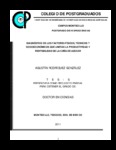Diagnóstico de los factores físicos, técnicos y socioeconómicos que limitan la productividad y rentabilidad de la caña de azúcar
Abstract
El presente trabajo se llevó a cabo durante la zafra 2010-11 en la zona central del estado de Veracruz (18°51’24” y 19°05’47” latitud norte; 96°26’52” y 96°48’25” longitud oeste) en el que se planteó que la disponibilidad de humedad y el manejo de la fertilización son factores que limitan la productividad de la caña de azúcar en condiciones de secano. Con base en el registro histórico de 10 estaciones climáticas, se delimitaron tres áreas con distinta pluviometría y una con riego como referencia. La problemática técnica se evaluó a partir del conocimiento local mediante la aplicación de encuestas a 500 cañeros (20% del total de agricultores de la zona de interés) y en cada parcela se midió el rendimiento de caña. Los datos obtenidos en campo (rendimientos y ciclo actual) y encuestas (uso y manejo de los fertilizantes) se agruparon por condición de humedad. Aunque en la zona existe un gradiente de lluvia significativo, sólo fue estadísticamente diferente el rendimiento de caña de las zonas con mayor disponibilidad de humedad (riego y zona húmeda) respecto a las de menor pluviometría (zona de transición y la seca). Se aplica la misma dosis de fertilizante en toda el área, sin importar el ciclo de la caña (plantilla, soca o resoca), rendimiento y volumen de lluvia, por lo que es indispensable promover un manejo de nutrientes acorde a cada situación, conciliando el requerimiento nutrimental del agrosistema cañero con aspectos económicos, como es el suministro de insumos en el área de abasto. _______________ DIAGNOSIS OF PHYSICAL, TECHNICAL AND SOCIOECONOMIC LIMITING PRODUCTIVITY AND PROFITABILITY OF SUGAR CANE. ABSTRACT: The present work was carried out during drip jar 2010-11 in the central zone of the state of Veracruz (18°51'24” and 19°05'47” North latitude; 96°26'52” and 96°48'25” west longitude) it was considered, that the humidity availability and the handling of the fertilization are factors that limit the productivity of the sugar cane in conditions of dry land. With base in the historical registry of 10 climatic stations, three areas with different pluviometry and one with irrigation like reference were delimited. The problematic technique was evaluated from the local knowledge by means of the application of surveys to 500 cane growers (20% of the total of agriculturists of the zone of interest) and in each parcel, the cane yield was moderate. The data collected in field (yields and present cycle) and surveys (use and handling of fertilizers) were grouped by condition of humidity. Although in the zone a significant rain gradient exists, the cane yield of the zones with greater humidity availability was only statistically different (irrigation and humid zone) with respect to those from smaller pluviometry (zone of transition and the drought). The same dose of fertilizer in all the area was applied, without concerning the cycle of the cane (its soles, soca or resoca), yield and volume of rain, reason why it is indispensable to promote an agreed handling of nutrients to each situation, being conciliated the nutrimental requirement of cane system with economic aspects, as it is the provision of consumption in the supply area.
Collections
- Tesis MC, MT, MP y DC [274]

